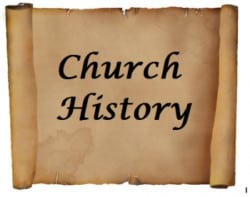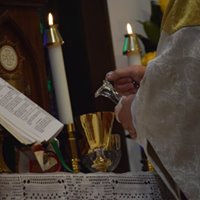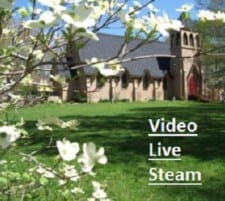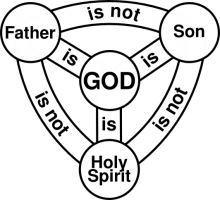Confirmation Class 5
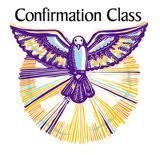 Class 5
Class 5
Important Endnotes
(Applicable End Notes – Please read as it contains vital information!!)
[i] The Christian faith, as explained by Lancelot Andrewes, is “one cannon given of God, two testaments, three symbols (Apostles’, Athanasian, and Nicene creeds), the four first councils of Nicaea I: 325; Constantinople I: 381; Ephesus: 431; Chalcedon: 451, and first five centuries and the series of Fathers therein.”
[ii] During the 1960’s, 1970’s, 1980’s until the present, Episcopalians began to make unscriptural decisions and promote unscriptural positions. First, they changed the Prayer Book and thus they changed many of the prayers, often at the expense of antiquity. Thus changed, without the full communion support – basically “on their own” a two thousand year tradition as they began to ordain women as clergy. Just like the Early Church, some Episcopalians began to teach things that are contrary to the historical teachings of the Church. Some said that Jesus is not God or that He did not rise from the dead. Others endorsed positions that are contrary to Scripture (homosexuality and abortion.)
Many concerned Episcopalians began to gather in various US cities during the 1960’s and 1970’s. They felt threatened that they would not longer be under under a valid Bishop and be given priests which were not of the male character of Christ and that their “priest” would begin to teach things that are not part of the Traditional Faith.
Several of these people decided that in order to protect the teaching and worship of the Church, they would ask Bishops from all over the world to provide them with bishops and priests of their own as they began to set up small churches. Just as the English under Henry VIII, they did not claim to set up a new church from scratch. They received Holy Orders from bishops who succeeded the Apostles, and they taught from the Bible using the Book of Common Prayer as their guide. God provided for His Church.
These brave Anglicans were pioneers and set an example for others around the world who felt their Anglican Heritage was being changed and/or discarded. They were called “Traditionalist” and “Continuers.” St. Michael’s is one of the churches. It is a parish of the Diocese of the Eastern United States, which is under the jurisdiction of the Anglican Province in America. History; The present structure of the Anglican Province of America (APA) was erected in 1998, constituted by the Diocese of the Eastern United States and the Missionary District of the West. In 2000, the Missionary District of the West became a Diocese in its own right and in the 2008, the Diocese of Mid-America was erected in the central U.S. from the non-geographical Diocese of St. Augustine, which had come into union with the APA in 2004. The history of the APA, however, stretches back to 1968 with the founding of the American Episcopal Church (AEC) in response to the heretical teachings of Episcopal Bishop James Pike, the Social Gospel Movement in the mainline Protestant churches, and the liturgical movement spawned by the dramatic liturgical revisions of Vatican II. Our Diocese of the Eastern United States is the same diocese first erected in the old AEC, the first of the modern so-called “Continuing Churches.”
In 2017, The Anglican Province of America signed a Letter of Unity with Anglican Catholic Church, the Anglican Church in America, and the Diocese of the Holy Cross.
[iii] Knowing this first, that no prophecy of scripture is of any private interpretation…but (by) holy men of God spake as they were moved by the Holy Ghost. [iii] 2 Peter 1:20-21.
[iv] “To make religion nothing but an auricular profession, a matter of ease, a mere sedentary thing, and ourselves merely passive in it; sit still, and hear a Sermon and two Anthems, and be saved, as if by the act of the choir, or of the preacher, we should so be, (for these by their acts,) and we do nothing ourselves, but sit and suffer, without so much as anything done by us, any effundan (pouring) on our parts at all; not so much as this, of calling on the Name of the Lord.”
Religion to Andrewes was not just something “inward” but “outward” as well. The visible church was something very real to Andrewes as it had represented the Church of Christ from its beginning, having continuity with apostolic times which had been visible throughout its history. Thus he would strive to establish the English Church upon the ground of scripture and the early church. Andrewes had a nostalgic longing for the days of Christian unity and had an understanding of the Protestant Movement within the Church of England as he wrote to Bellarmine, “The people of the reformed churches have suffered no shipwreck of the faith, they reject no creed of the old Church, they admit all.”
Having determined the Christian Faith by examining the Canonized Scripture, the early Church Fathers, and the first four ecumenical councils, Andrewes undertook the task of formalizing the patterns which he believed should prevail in the English Church. This meant that he must defend the English Church against the onslaught of Roman Catholicism, and he also must bring his defense against some of the Puritan tendencies within the Church itself. With the Puritans it could be argued that Andrewes had more of a problem with their form of government than with the essentials of religion. As there was order and structure in God’s Creation, Andrewes believed that structure and order were proper for Christ’s Church. As he observed the many changes that the Puritan’s brought to the structure of church government, which was different than the English Church, he viewed the changes as disorder and the undoing of the current church in England. This meant that he had to face the problem, as far as the English Church was concerned; of propagating the idea of the continuity of a Catholic early tradition in the Church despite the break occasioned by Henry and later Elizabeth, as he had to promote the idea of Catholicism that was episcopal, but not papal. At the same time Andrewes sought to reduce the Puritan tone of earlier Elizabethan Anglicanism. His desire was to take the historical legitimacy of both by taking the same road of the early Church.
[v] Roman charge from Cardinal Bellermine in his Responsio ad librum: Triplici nodo, triplex cuneus (1608) that a man cannot be called “Catholic” who rejects transubstantiation, the temporal claims of the papacy, and the invocation of saints. This charge opened the door for Andrewes to enter into the apologetic field in defense of the Church of England. In doing so, he continues a theme of walking a path which the early fathers of the church traveled. He sought no new doctrines or ways of worship as he responded:
“Much detriment has the catholic faith suffered at your (Church of Rome) hands; much filth has it contracted much, from which it is no disgrace to us that we revolt…This filth has lately, in some parts of the world, been washed off, and the form…originally possessed has been restored. To this faith we cling as reformed; not to your deformation of it. Our religion you miscall modern sectarian opinions. I tell you if they are modern, they are not ours; our appeal is to antiquity yea, even to the most extreme antiquity. We do not innovate; it may be we renovate what was customary with those same ancients, but with you has disappeared in novelties…Subjection to Rome, dependence on Rome this is the sum of your religion.”
He defended the church against Roman influence as well as the Puritan strain of worship within the Church. Condemning responses to the Roman Church, he referenced the past, to determine the future; however, his attitude towards the Puritans was gentler:
“Andrewes had no liking for compulsion; he trusted mainly to the power of persuasion to win and control the unruly and excited spirits about him. In one of his sermons he draws a beautiful picture of the true prince who “leads” his people, and does not “drag” them…Our guiding must be mild and gentle…Laud represents another method, that of legal coercion…Andrewes was in favor of gentle and gradual…he trusted to the educational influence, which indeed was already very marked…more belief in human nature than Laud, and it was an evil day for the Church when his presence was withdrawn.”
In seeking to remain faithful to early church tradition, he followed a road already traveled within both testaments as he looked for direction. The words from the Old Testament would be a guide to him:
Hb 2:20, “The Lord is in his holy temple; let all the earth keep silence before him,” and Ps 96:9, “O worship the Lord in the beauty of holiness; let: fear before him, all the earth,” and of the New Testament Jn 4:23, “The hour cometh, and now is, when the true worshippers shall worship the Father in spirit and truth: for the Father seeketh such to worship him.”
[vi] Nicolas Lossky, Lancelot Andrewes the Preacher (1555-1626): The Origins of the Mystical Theology of the Church of England, (Oxford: Clarendon Press, 1991), 6. “But if, on the other hand, to make a theology means to make more and more truly one’s own, by experience, the mystery of the relationship of God to man that has been traditionally lived by the Church, then originality will consist not so much in innovation, as enabling a whole era to grasp the genuine essence of the Christian message. In fact, the more the theologian penetrates into the heart of the mystery, the more his teaching will be personal, and consequently original.
[vii] Example is the “real presence” doctrine of the Eucharist. The difference between Roman Catholic Church doctrine of transubstantiation and the “real presence” view of the Church of England. Andrewes believed transubstantiation could not be an expression of faith, as it was a metaphysical explanation of how Christ was truly present within the Eucharist. He would write to Cardinal Bellarmine that English Christians believed no less than Roman Catholics that the Eucharistic presence was indeed real, but that they do not define the mode of that presence.
“Christ said “this is my body.” He did not say “this is my body in this way”. We are in agreement with you as to the end; the whole controversy is as to the method. As to the “This”, we hold with firm faith that it is. As to the “this is in this way”, (namely by the Transubstantiation of the bread into the body), as to the method whereby it happens that it is, by means of In or With or Under or By transition there is no word expressed [in Scripture]. And because there is no word, we rightly make it not of faith; we place it perhaps among the theories of the school, but not among the articles of the faith…We believe no less than you that the presence is real. Concerning the method of the presence, we define nothing rashly, and I add, we do not anxiously inquire, any more than how the blood of Christ washes us in Baptism, any more than how the human and divine natures are united in one Person in the Incarnation of Christ.”
[viii] Bede: Ecclesiastical History of the English People; P.51 – “In fertile Britain’s land was noble Alban born… Alban, yet a pagan (286AD) gave shelter to a Christian Priest fleeing from his pursuers. And when he observed this man’s unbroken activity of prayer and vigil, he was suddenly touched by the grace of God and began to follow the priest’s example of faith and devotion … The priest lay hidden in Alban’s house … orders given to make a thorough search of the pagan’s house, and when they arrived at Alban’s house, holy Alban, wearing the priest’s long cloak, at once surrendered himself in the place of his guest and teacher, and was led bound before the king to be executed.


